THE AIRPORTS
SOUTHERN CALIFORNIA
SAN DIEGO
SAN
| The San Diego International Airport claim to fame can be based upon the fact the Charles Lindbergh tested the Spirit of St. Louis on the spot destined to become the city's airport. After the historic trans-Atlantic flight, the city purchased the land and built a municipal airport and christened it San Diego-Lindbergh Field in recognition of Lindbergh's San Diego history. In June 1930, regular Air Mail service was started to Los Angeles and passenger flights began under United Air Transport (later United Airlines.) Airlines slowly added San Diego as a destination, especially due to the large military presence in the region. Hometown airline, Pacific Southwest Airlines (PSA), started flying in 1949 and placed San Diego as a destination firmly on the map. By 1957, the airport was being served by five airlines including two national carriers, American Airlines and United Airlines. In 1967, a new, modern terminal was constructed and expansion of flights and airlines serving the airport commenced. By the 1970s, San Diego had added two more nation carriers, both National Airlines and Delta Airlines had over one-hundred flights daily and had non-stop flights to thirteen cities including Honolulu and Mexico City. The 1980s saw a surge of new airlines both international and national serve the airport as the destination of "America's Finest City" had finally come to fruition. |
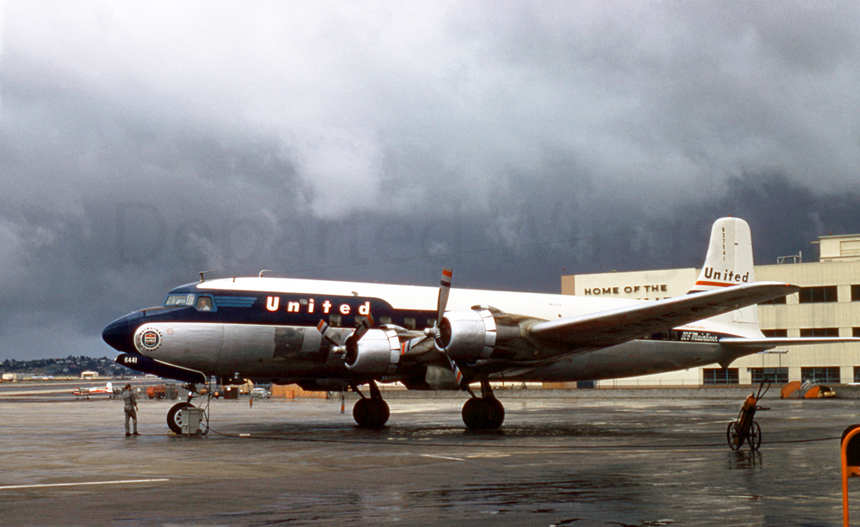
|
April 1956 United Air Lines was one of the first airlines to start passenger service into San Diego in 1930 as the last southern destination on its pioneering multi-city Pacific Coast service. For the next thirty years, United served San Diego from Los Angeles only, providing passengers convenient connections for flights continuing on in the United system. Early flights used the Boeing 247, followed by the Douglas DC-3, Douglas DC-4, and by the 1950s the Douglas DC-6. Seen parked on a wet ramp, during a spring storm and getting prepared to depart is N37541"Mainliner Colorado," a Douglas DC-6, delivered new to the airline on August 31, 1948. |

|
October 1957 Las Vegas based local carrier Bonanza Air Lines started service into San Diego in 1952, using a Douglas DC-3 as in intermediate station on its new multi-stop Phoenix-Los Angeles service. Two daily flights in both directions, operated the over four hour Phoenix-Blythe-Yuma-El Centro-San Diego-Oceanside-Santa Ana-Los Angeles route. Taxiing away from the original Pacific Highway Terminal for a continuing northbound flight is N495 "The Washoe Queen," a Douglas C-53B, purchased by the airline in December 1949. |
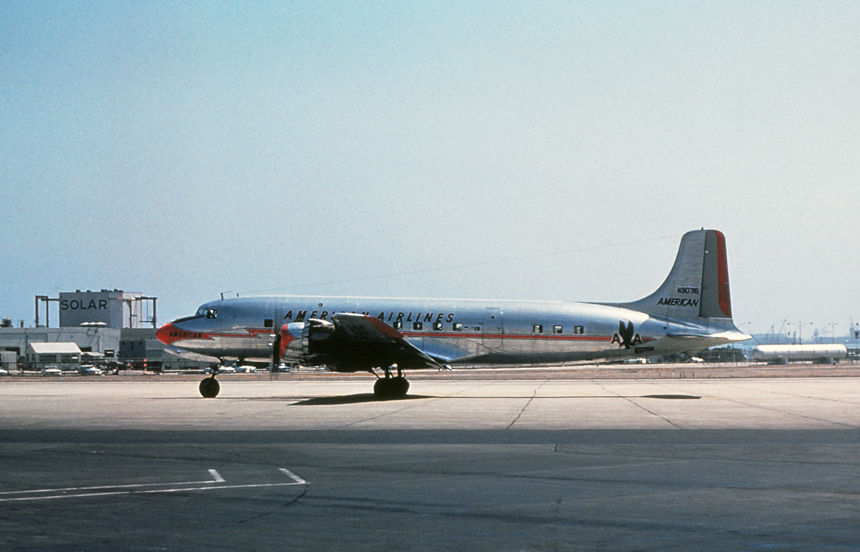
|
September 1959 As one of the first national airlines to start commercial passenger service into San Diego Airport, American Airlines had expanded service to Phoenix, Tucson, Los Angeles, and Dallas using both Douglas DC-6 and DC-7 aircraft. During 1959, American was the only airline to provide non-stop service beyond the neighboring states of Nevada and Arizona. Taxiing away from the terminal complex for an afternoon departure is N90716, a Douglas DC-6 delivered new to American Airlines in May 1947. |
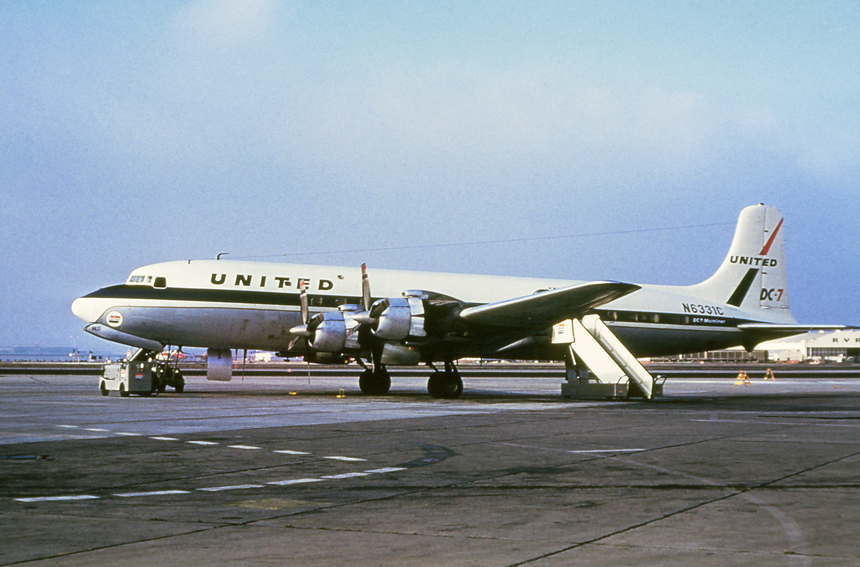
|
June 1960 United Air Lines was a customer of Douglas Aircraft's last piston powered airliner the Douglas DC-7. Introduced in 1953, the DC-7 had transcontinental range, as well as being the fastest airliner at the time. United used the DC-7 Mainliners on East Coast to West Coast flights, and trans-Pacific routings and San Diego saw the luxurious DC-7s on flights to Los Angeles continuing onto Chicago or Denver. Parked at the Pacific Highway Terminal and waiting for a load of passengers on an overcast morning is N6331C, "Mainliner Kansas City" a Douglas DC-7. |
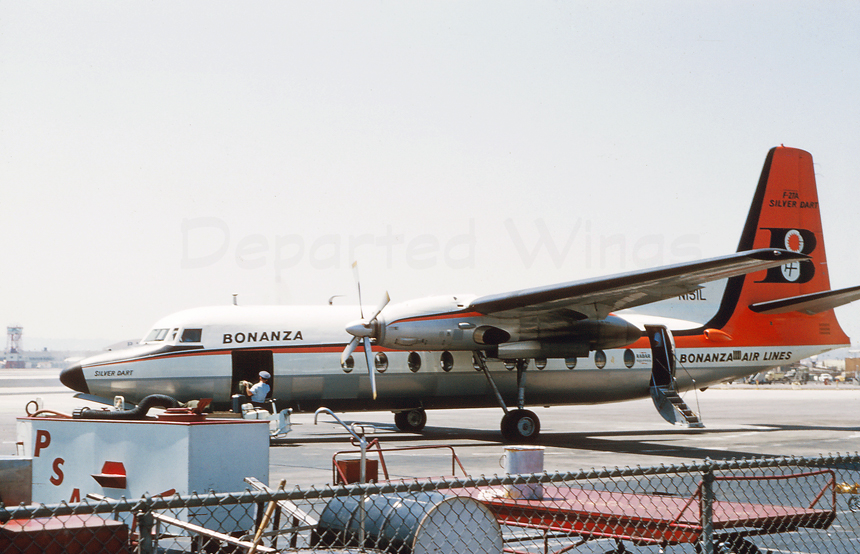
|
August 1960 Bonanza Air Lines was the first airline to start "jet" service into San Diego when in the spring of 1959 the airline introduced its new Fairchild F-27 "Silver Dart" turboprops on flights to both Los Angeles and El Centro (continuing on to Phoenix). Parked on the ramp at the Pacific Highway Terminal and being loaded for an afternoon departure is N151L, a Fairchild F-27A, delivered new to the airline a few months earlier on one May 6, 1960. |
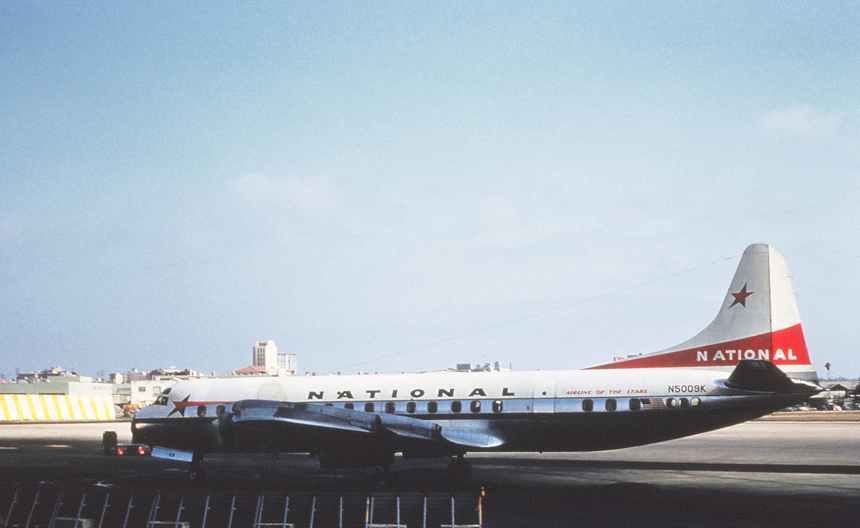
|
January 1961 National Airlines was able to trace its roots back to 1937 and its start as an air mail carrier between St. Petersburg and Daytona Beach, Florida. Over the next twenty-years, National Airlines evolved to become a formidable carrier along the Eastern Seaboard and Southeastern regions of the U.S. Seeking to extend its wings, the airline signed a interchange agreement with both Delta Airlines and American Airlines in 1951, to provide "one-plane" service between Miami and San Diego, Los Angeles and San Francisco. The National aircraft would travel as far west as New Orleans when the Delta crew would take over, followed by a change of crew in Dallas-Ft. Worth for which American Airlines would complete the flight west. During 1960, the Civil Aeronautics Board (CAB) recommended that National be awarded routes as part of the Southern Transcontinental Service Case. This award gave National the rights to fly its own aircraft on west coast services directly from Miami and Houston. San Diego had National Airlines services start on June 11, 1961, to both Los Angeles and Houston, Texas, using a Lockheed Electra Turboprop. Taxiing away from the Pacific Highway Terminal for a late afternoon flight north to Los Angeles is N5009K, a Lockheed L-188A Electra. |
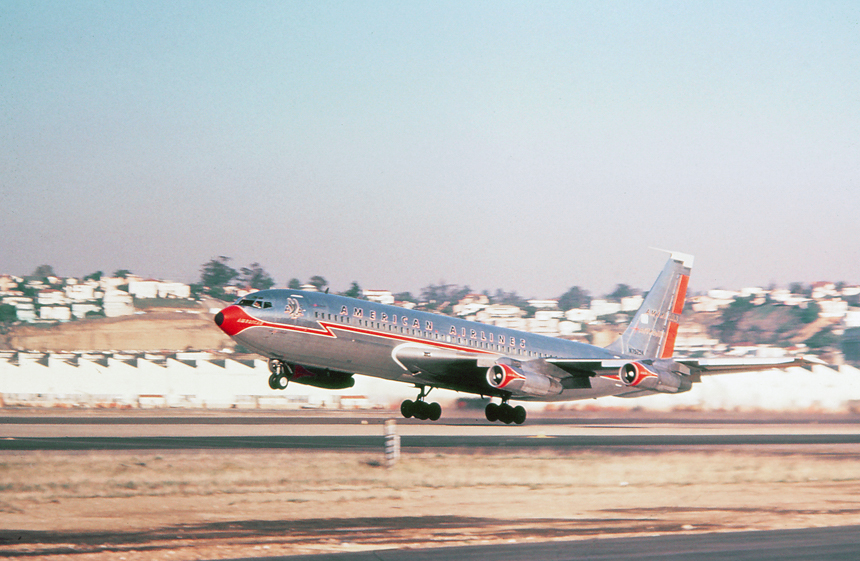
|
August 1961 American Airlines was one of the first commercial airlines to start service into San Diego and became the first airline to start "jet" service into San Diego in August 1960, using their brand new Boeing 707 aircraft. Initial services were between San Diego and both Dallas and Los Angeles. Caught rotating for takeoff on Runway 27 is N7525A, a Boeing 707-123, delivered new to American Airlines in November 1959. |

|
March 1962 The San Diego area was well known for its aerospace industry and one of the largest companies was Convair located at San Diego-Lindberg Field. Although Convair was well known for its military aircraft, the company ventured into the commercial jet aviation market in the 1956 with a proposed narrow-body four-engine airplane initially known as the "Skylark." Convair ended up producing two airlines; the Convair 880 and Convair 990, both of which had unique characteristics and broke many speed records. Unfortunately the Convair airlines never caught wide-spread popularity, resulted in tremendous financial losses to the company and after a short run of only 103 airframes, production was stopped in 1963. See rotating for takeoff from Runway 27 on a delivery flight to American Airlines, with the Convair plant in the background is N5608, a Convair 990-30A-5. |
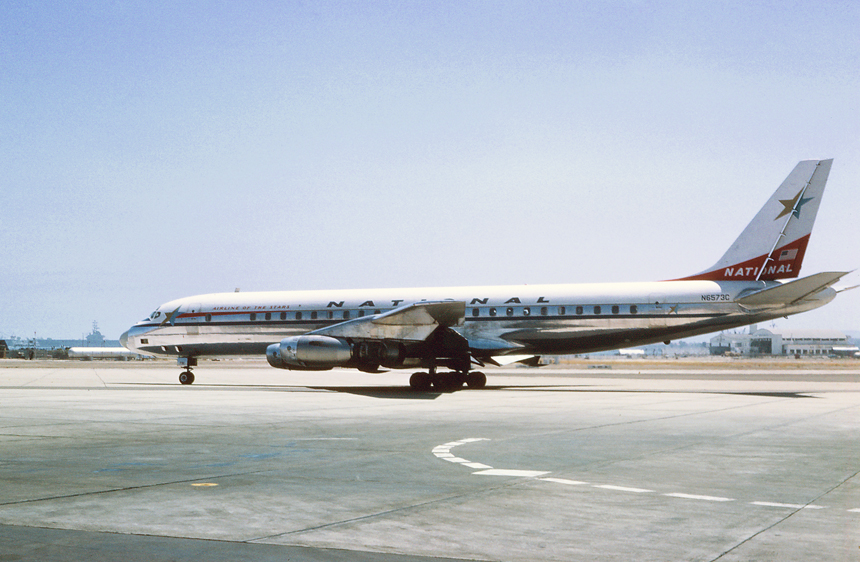
| June 1962 On June 1, 1962, only a year after National Airlines had inaugurated service to San Diego did the airline upgrade equipment on the route by introducing the Douglas DC-8 "Jet" on non-stop services from San Diego to both Los Angeles and Houston. For the next seventeen years, National Airlines proved a popular carrier at San Diego, eventually introducing the Douglas DC-10 Tri-jet on routes to Los Angeles, Houston and New Orleans, before its purchase by Pan Am in January 1980. Departing the ramp at the original passenger terminal building located on Pacific Coast Highway is N6573C, a Douglas DC-8-21, wearing the classic "Airline of the Stars" colors and delivered new to National in December 1960. |

|
April 1963 United Air Lines become the second airline (American was the first) to introduce jet flights in San Diego in September 1960, using the Boeing 720 on "Jet Mainliner" services to Los Angeles. United introduced the Douglas DC-8 into its fleet in September 1959, and the four-engined jet was soon seen at San Diego providing connecting flights to Los Angeles. Taxiing away from the Pacific Highway Terminal for an afternoon departure is N8038U, a Douglas DC-8-21 delivered new to United in February 1961. |
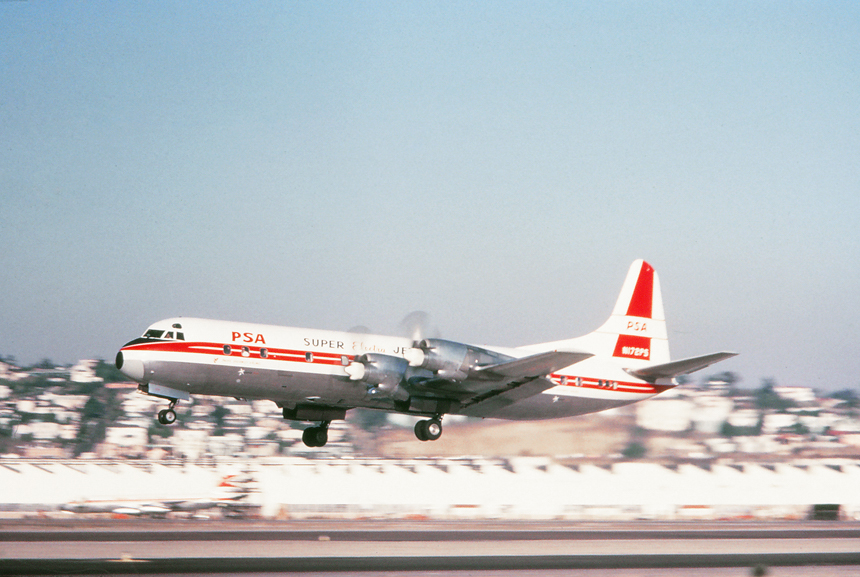
|
November 1963 Pacific Southwest Airlines (PSA) introduced the Lockheed Electra in 1959 to establish turboprop "jet" service on routes to the Bay Area. The first three aircraft were delivered just in time for the Christmas rush of 1959 and were used to replace the aging Douglas DC-4. The Electra would remain a formidable aircraft in the PSA fleet until their final replacement with true jet equipment in 1969 (The Electra's did return in the late 1970s for new service to Lake Tahoe). Caught rotating for takeoff from Runway 27 during a mid-day flight is N172PS, a Lockheed L-188 Electra-C, delivered new to PSA in November 1959. |

|
January 1964 By the early 1960s, the original passenger terminal located at the east side of the airport was becoming congested. The city had decided that a new terminal would be needed and started the process to fund and design a new passenger terminal located along unused land along the southwest perimeter of the airport boundaries. The new terminal complex would relive congestion and allow for continued growth in the Jet Age. Parked at the passenger terminal on Pacific Highway during a crisp winter evening is N7503A, a Boeing 707-123 and subsequently the aircraft that started transcontinental jet service between Los Angeles and New York on January 25, 1959. |
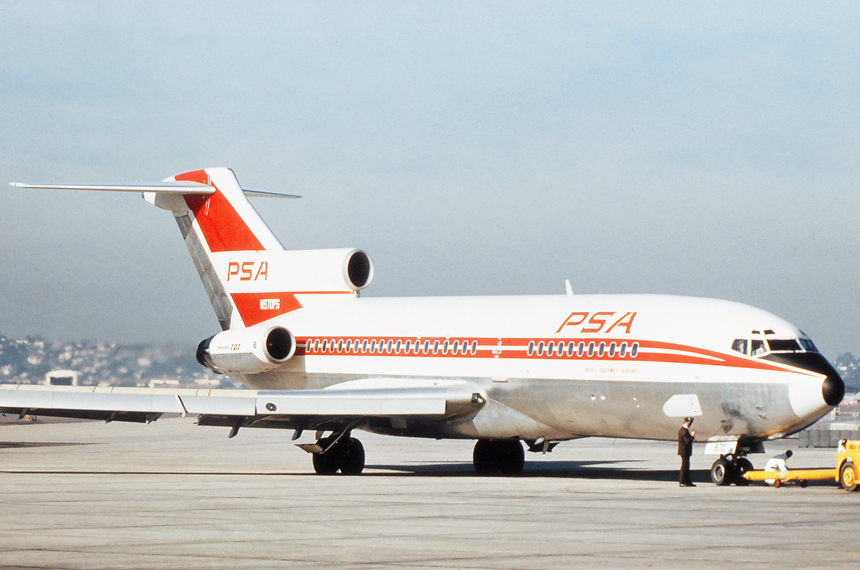
| July
1967 In an effort to better compete with mainline carriers and bring the airline into the "jet" age, Pacific Southwest Airlines (PSA) placed an order in 1964 for six, of the new Boeing 727-100 jetliners. The first 727 was placed into service on April 9, 1965 on the San Diego-San Francisco route followed by placement on the popular yet highly competitive Los Angeles-San Francisco flights. The new Boeing 727s were successful and would eventually become the mainstay of the PSA fleet into the early 1980s. Having just been pushed back for a mid-morning northbound flight is N970PS, a Boeing 727-14, delivered new to PSA on April 5, 1965. |

|
September 1967 United San Francisco based local service carrier Pacific Air Lines flew mostly regional routes across Central and Northern California and as far south as Los Angeles. San Diego was added to the airline's route map in July 1962 with a single daily flight to Long Beach using the Fairchild F-27, Seen parked on the ramp at the west end of Terminal One and awaiting passengers for an early afternoon departure is N2778R, a Fairchild F-27A, delivered new to the airline in April 1964. |
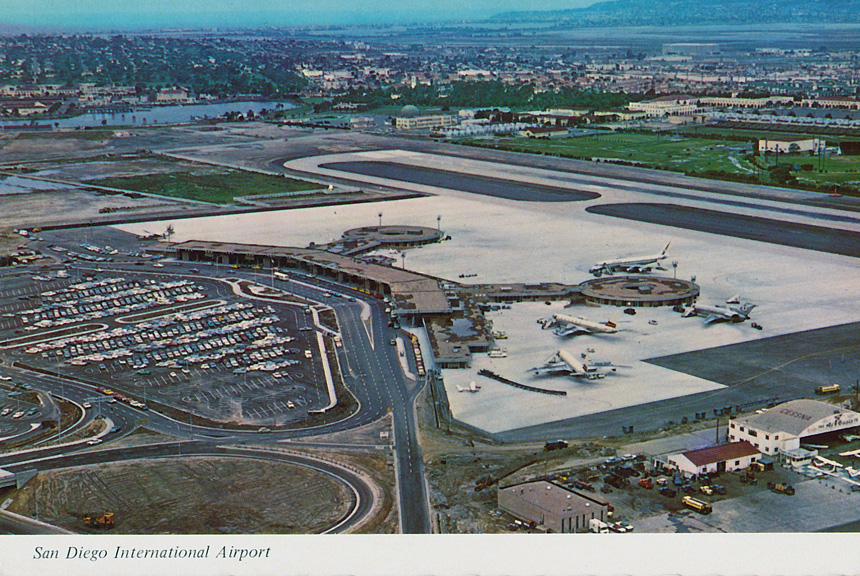
|
1968 San Diego International Airport had used a passenger terminal on the east side of the airport along Pacific Coast Highway. That original terminal had been in use since 1931, and with the growing demand for air travel was becoming rather inadequate to host the increase of traffic. When the jet age dawned at San Diego in 1960, the original terminal ramp became even more congested and the eight existing passenger gates increasingly crowded. The Port Commission issued a bond to construct a new airport terminal and related facilities. The new terminal would be on the southern end of the airport complex along Harbor Drive and would have over 1,000 parking spaces and twenty passenger boarding positions. The new terminal was placed into service on March 5, 1967, and the older one finally retired. Seen from the air, the new San Diego-Lindberg Field airport terminal is busy with activity. Seen on the ramp is two Western Airlines Boeing 707s (bottom left), an American Airlines Boeing 727, a United Air Lines Douglas DC-8 and in the upper left of the terminal a lone Pacific Airlines Fairchild F-27 sits awaiting passengers. (Postcard) |
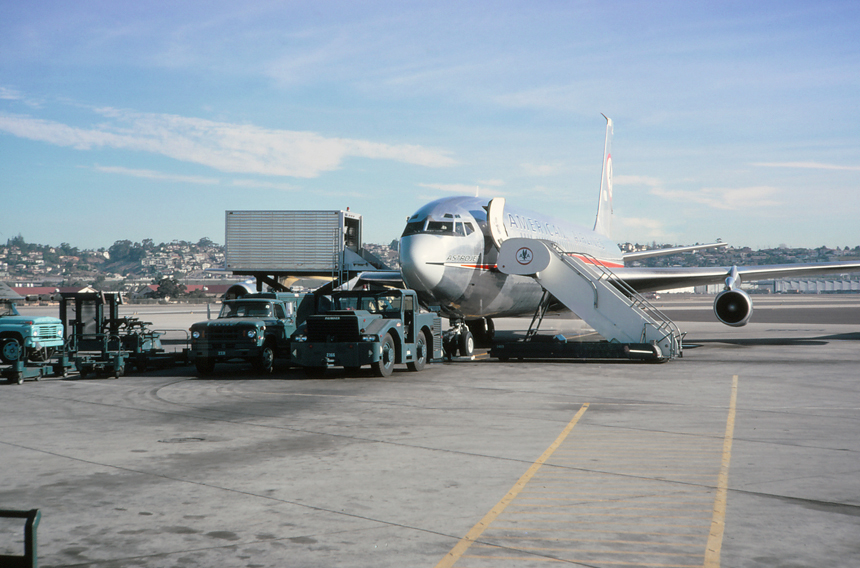
|
February 1968 Next to Pacific Southwest Airlines PSA, American Airlines was one of the busiest carriers to serve the San Diego Airport. When the airline relocated into the new Terminal 1 in 1967, it had over ten flights daily from the airport. Both 727 and 707 aircraft were used on flights as close as Los Angeles as well as to other points east. By 1970, American had placed the 707 on most of the medium and transcontinental routes from San Diego including flights to Albuquerque, Chicago, Dallas, Los Angeles, Phoenix, Tucson and Washington Dulles. Parked on the ramp at the new terminal and being serviced before another flight is a Boeing 707-123B. |
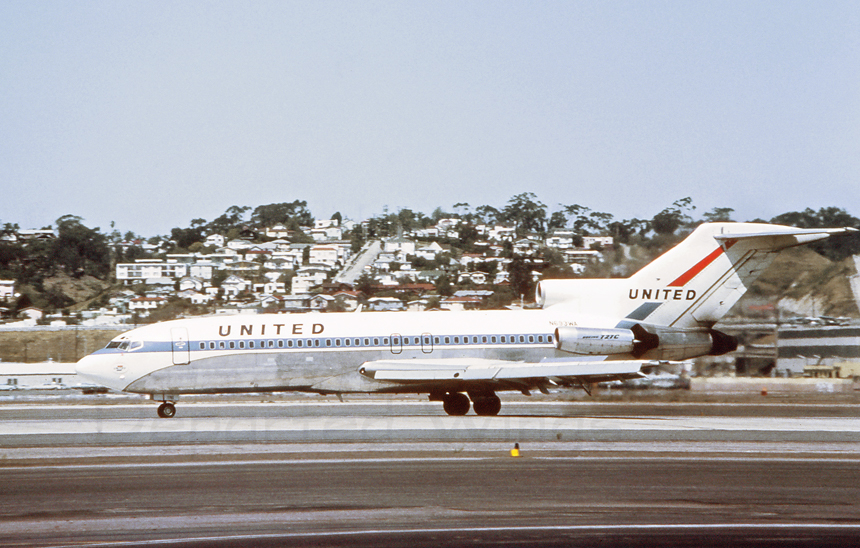
|
April 1968 When United Air Lines received its first medium-range Boeing 727 in October 1963, the new planes were quickly rotated into the fleet replacing the larger jets on short and medium range services. San Diego saw the new tri-jet in 1964, and would be a familiar site at the airport for the next thirty years. Rolling out on Runway 27 after having just landed after a quick flight from Los Angeles is N693WA, a Boeing 727-173C, originally delivered to World Airlines as a "Combi" in September 1967, and subsequently purchased by United Air Lines a month later. |
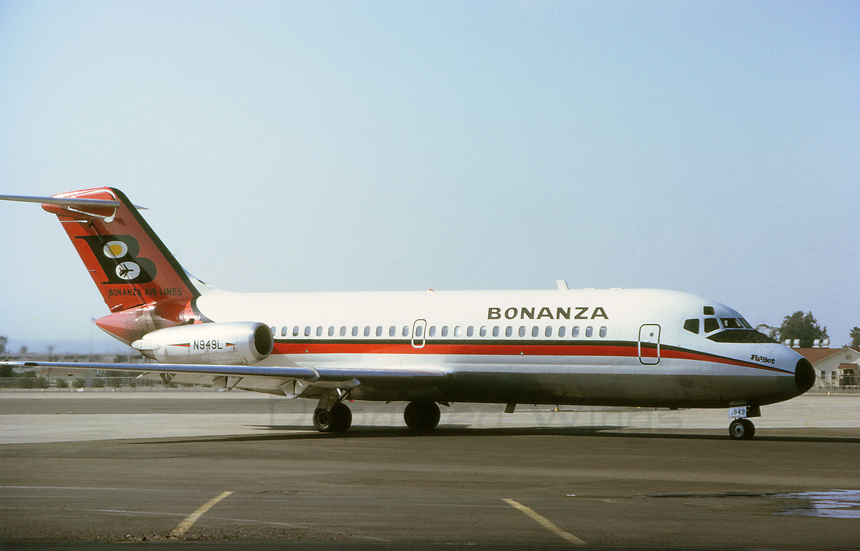
| April 1968 During April 1959, Bonanza Air Lines started the first jet-powered passenger service into San Diego using Fokker F-27A turboprop aircraft. In an effort to better compete with the mainline carriers on flights between major city pairs, Bonanza purchased the Douglas DC-9 with the first plane being delivered 1966. San Diego was introduced to the new DC-9, dubbed "Fun Jet," in early 1967, with flights to both Tucson and Los Angeles. The Bonanza DC-9s continued to serve San Diego until the airline was merged with Pacific Air Lines and West Coast Airlines a year later in April 1968, with the formation of AirWest. Seen taxiing out toward Runway 27 for a later afternoon departure is N949L, a Douglas DC-9-14, delivered new to the airline in October 1967. |
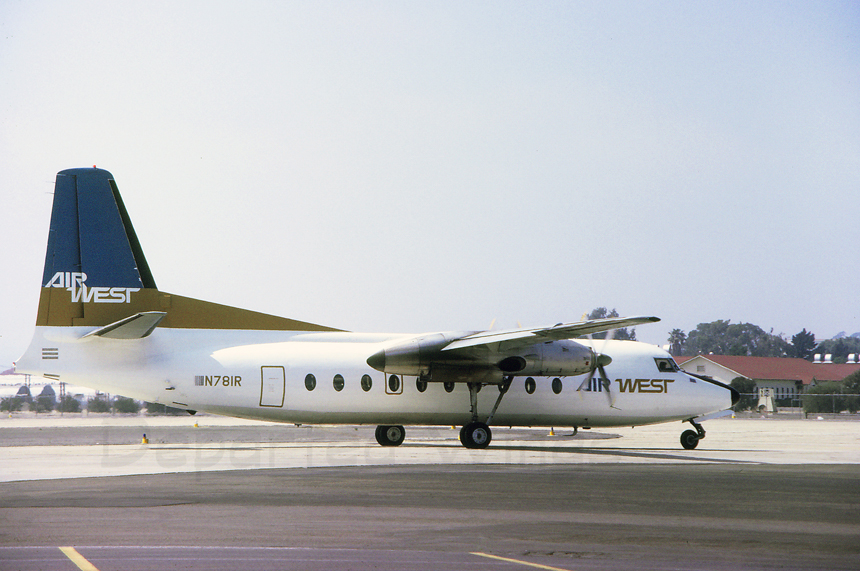
|
May 1968 With the merger of Bonanza Air Lines, Pacific Air Lines, and West Coast Airlines in April 1968 to form AirWest, the new airline became a common sight at San Diego having consolidated the routes of both Bonanza and Pacific Air Lines. Initial AirWest flights connected San Diego with Santa Ana-Orange County and El Centro-Imperial with Fairchild F-27s and Douglas DC-9 flights to Burbank, Los Angeles, and Tucson. Seen taxiing away from the terminal for a mid-morning flight to El Centro-Imperial is N781R, a Fairchild F-27A, originally with Pacific Air Lines. |
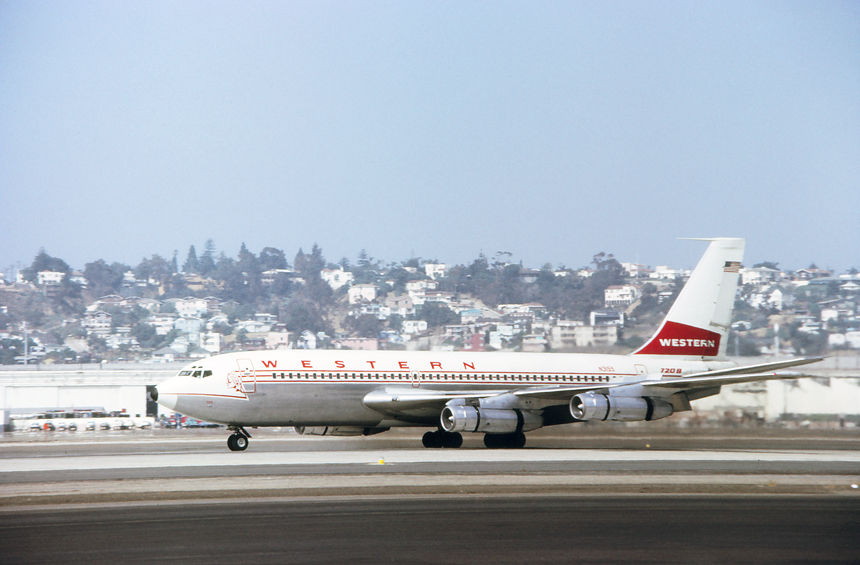
|
May 1968 Western Airlines was one of the first passenger airlines to start service into San Diego in 1930, with flights to Los Angeles via Long Beach. Western continued to expand at San Diego and became a well established carrier for the next fifty-seven years. The airline introduced Boeing 720 "Fan Jet" service to the airport in 1963 on flights to both Los Angeles and Phoenix. By 1968, the Boeing 720s were also providing "Fiesta" flights between San Diego and Mexico City. Seen rolling out on Runway 27 after having landed is N3155, a Boeing 720-047B, delivered new to the airlines on August 16, 1967. |

| May 1968 Long Beach based Aero Commuter had quickly grown to become a formidable commuter airline within the Los Angeles area. Service was started to San Diego in March 1968 with flights to Oceanside, continuing on to Long Beach. In May 1969, Aero Commuter along with Skymark Airlines, Cable Commuter, and Golden West Airlines were merged to form the "new" Golden West Airlines, however at the time of the merger service to San Diego was stopped, and not to be scheduled again until 1977 under the Golden West brand. Seen taxiing off Runway 27 and heading in toward the terminal is N63118, a de Havilland DHC-6-100. |
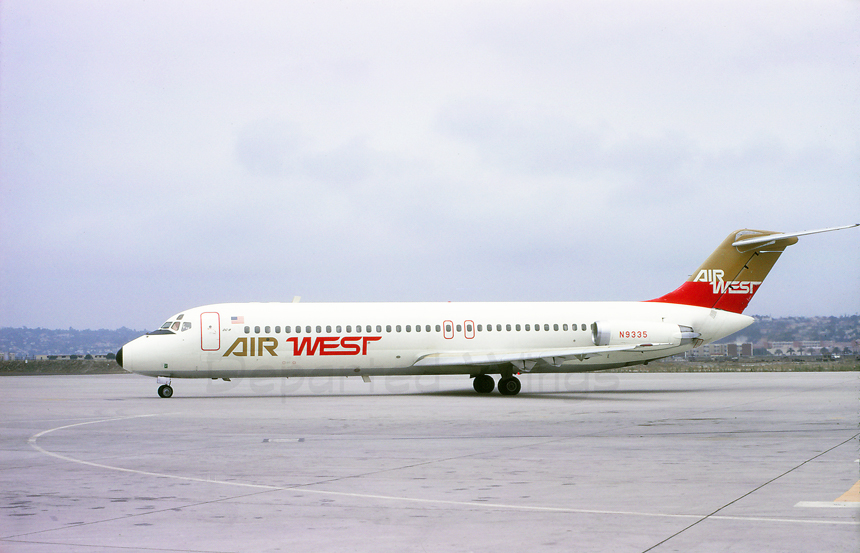
| June 1969 After the merger of Pacific Air Lines, Bonanza Air Lines, and West Coast Airlines into the new AirWest on April 17, 1968, the airline introduced a new bold "Fiesta" color scheme. The airline continued flights into San Diego using the Douglas DC-9s on services to Burbank, Los Angeles, and Tucson. Having just been pushed back and preparing to taxi away from Terminal One is N9335, a Douglas DC-9-31, delivered new to AirWest on November 27, 1968 |
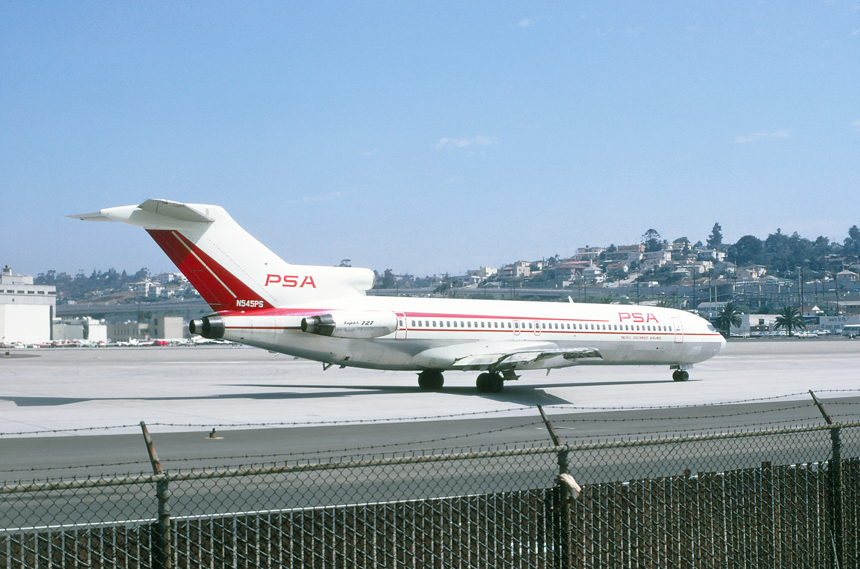
|
September 1970 Public reception of PSAs low fare, jet service was beyond positive, and the airline sought to increase its 727 fleet. In 1967, PSA ordered seven of the larger Boeing 727-200 series airplanes with a seating capacity of 158-passengers. The first Boeing 727-200 was delivered on December 19, 1967 and PSA was the first airline to place the "stretched" 727 into service on the west coast. The trusty Boeing 727 would serve as the foundation of the PSA fleet well into the early 1980s, when the last 727 flight was flown in November 1984. Seen holding short of Runway 27 for departure at San Diego Airport in September 1970 is N545PS, a Boeing 727-214. Note the "Super" titles on the engine nacelle, surely an effective marketing technique at the time. |
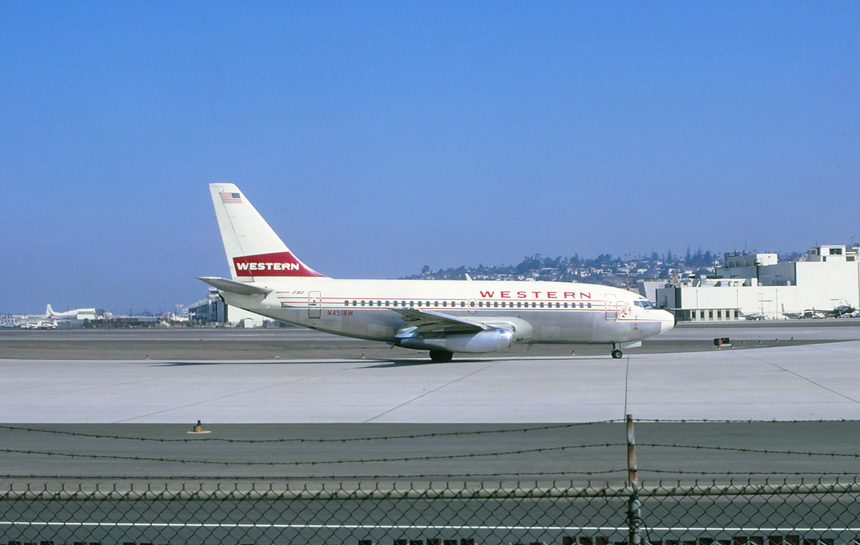
| September 1970 When Western introduced Boeing 737 service in 1968, San Diego was one of the first airports to host the new "Twin Jet", with services to Las Vegas, Palm Springs, and Long Beach. Taxiing out to Runway 27 is N4518W, a Boeing 737-247, in the classic "Indian head" color scheme. |

|
September 1970 Although United Air Lines wasn't the largest carrier at San Diego (actually fourth in terms of flights), the airline connected San Diego to eight cities nationwide including New York-JFK, Washington Dulles and Chicago. United was also one of only two carriers to provide non-stop service to Honolulu, Hawaii from San Diego. The airline used the Douglas DC-8 and Boeing 720 on the longer routes, as well as the shorter routes north to Los Angeles, and was using the Boeing 727 on routes to Chicago, Los Angeles, and Seattle. Taxiing outbound for a morning departure is N7022U, a Boeing 727-22, delivered new to United Airlines in September 1964. |

|
December 1970 Intra-state carrier Air California, based at Santa Ana-Orange County Airport started "Sun Jet" service into San Diego in November 1970, with flights to both Oakland and San Jose. The entry into the San Diego market was a sensitive subject as the newer start-up, Air California, had stepped into Pacific Southwest Airlines (PSA) territory although was flying to two destinations in Northern California non-stop that PSA wasn't serving directly. Parked at the terminal ramp and being turned around for another northbound flight is N464GB, a Boeing 737-293, delivered new to Air California in July 1968. |

|
May 1971 Wearing the "Fiesta" colors of fuchsia/rust orange and representing the colors of the striking Desert Southwest, N9104, a Douglas DC-9-10, originally delivered to West Coast Airlines in August 1967, is awaiting taxi clearance from Terminal One for a mid-morning departure. This aircraft was subsequently destroyed in a landing accident at Denver Stapleton International Airport while operating for Texas International Airlines on November 16, 1976. |

|
May 1972 United Air Lines first introduced "Jet Mainliner" service to San Diego in September 1960, using the Boeing 720 on flights to San Francisco. During 1961, United placed its DC-8 on various services from San Diego including flights to both Chicago and San Francisco. By the early 1970s, the DC-8 was being used on most of the long-range flights from San Diego to Chicago, Honolulu, New York-JFK, and Washington Dulles. Taxiing out toward Runway 27 for a morning departure is N8020U, a Douglas DC-8-21, delivered new to the airline in January 1960. |

|
July 1972 The flag carrier of the country of Mexico, had just completed a name change in early 1972, to a shortened version of Aeronaves de Mexico becoming just Aeromexico. Along with a name change came a new black and red color scheme with the traditional bold Aztec Eagle Warrior adorning the tail. San Diego was not a regular destination for Aeromexico, however the airline occasionally provided tour group charter flights from the airport to resort destinations in Mexico. Taxiing away for departure from the charter terminal, located at the east end of the airport when the original passenger concourse was once located is XA-SOY "Sinaloa", a Douglas DC-9-15. |

| April
1974 National Airlines service into San Diego had proved to be rather popular since the airline stated flights into the airport in 1961. Originally flying the Lockheed Electra then Douglas DC-8 on schedules to both Los Angeles and Houston, the airline eventually upgraded to the larger Douglas DC-10 and Boeing 727 during the early 1970s. Service continued on routes from San Diego to Houston and Los Angeles with new non-stop service to New Orleans added in July 1974. National continued to serve San Diego until its purchase by Pan Am in 1979. Taxiing out toward the runway for a mid-day departure to Los Angeles is N66NA "Shirley," a McDonnell Douglas DC-10-10. |
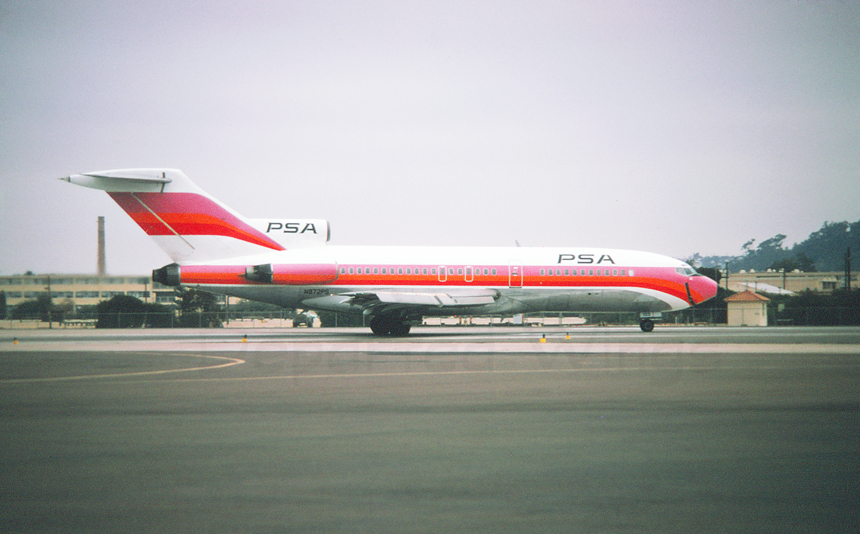
|
July 1974 Pacific Southwest Airlines PSA introduced a bold new color scheme in late 1972 with tri-colored stripes of red, orange, and fuchsia and statement to the airlines growth and prosperity. San Diego had no less then twenty daily departures to Burbank, Los Angeles, Oakland, and San Francisco using the Boeing 727 or Boeing 737. Seen taxiing outbound for an afternoon departure is N972PS, a Boeing 727-14, delivered new to the airlines on June 27, 1965. |
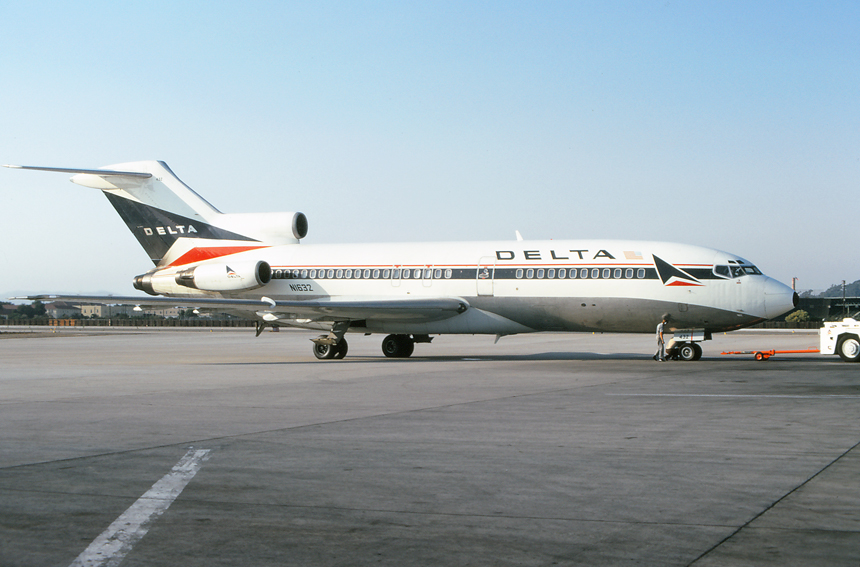
|
September 1974 Delta Airlines started service into San Diego in June 1961, as a result of the carriers award of the Southern Transcontinental Route Case by the Civil Aeronautics Board (CAB). That early service used both the Douglas DC-8 and Convair 880 on flights to both Los Angeles and Dallas-Ft. Worth. Occasionally the Boeing 727 would substitute service for the larger aircraft. Seen having just been pushed back from the gate at Terminal 2 and preparing to taxi outbound for an evening departure is N1632, a Boeing 727-95, originally delivered to Northeast Airlines in December 1965, assumed by Delta Airlines with the purchase of Northeast in August 1972. |

|
December 1974 Caught taxiing outbound to Runway 27 for a departure to Los Angeles on a crisp winter afternoon is N4754 "Gloria," a Boeing 727-235, delivered new to National Airlines in July 1968. |
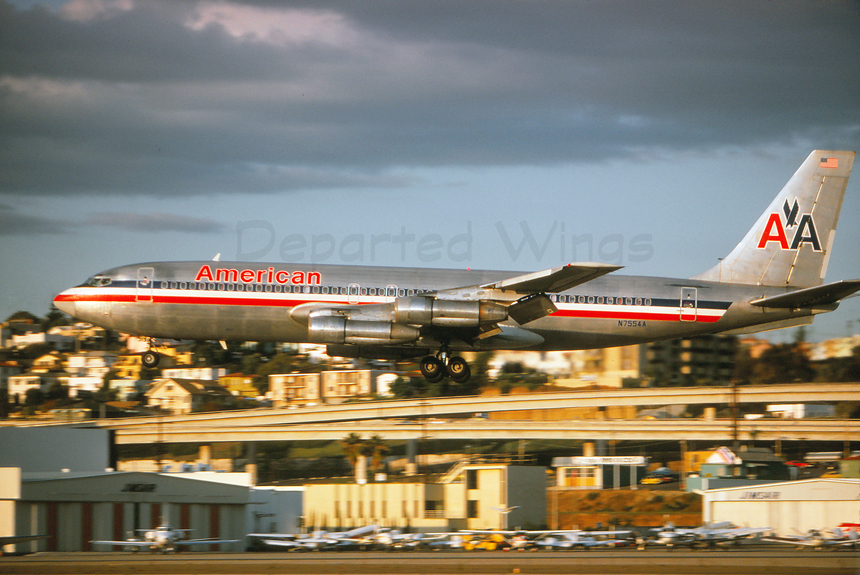
| December 1974 Just behind Western Airlines with numbers of cities served from San Diego in 1974, American Airlines had the distinction of the only carrier to provide non-stop service to major cities east of the Rockies (United Air Lines did have a Chicago non-stop as well). American had daily, non-stop departures from San Diego to Chicago-O'Hare, Dallas-Ft. Worth, Phoenix, Los Angeles and Washington-Dulles using the Boeing 707. Seen "over-the-numbers" for landing on Runway 27 on an early evening arrival is N7554A, a Boeing 707-123B, delivered new to the airline in April 1966. |
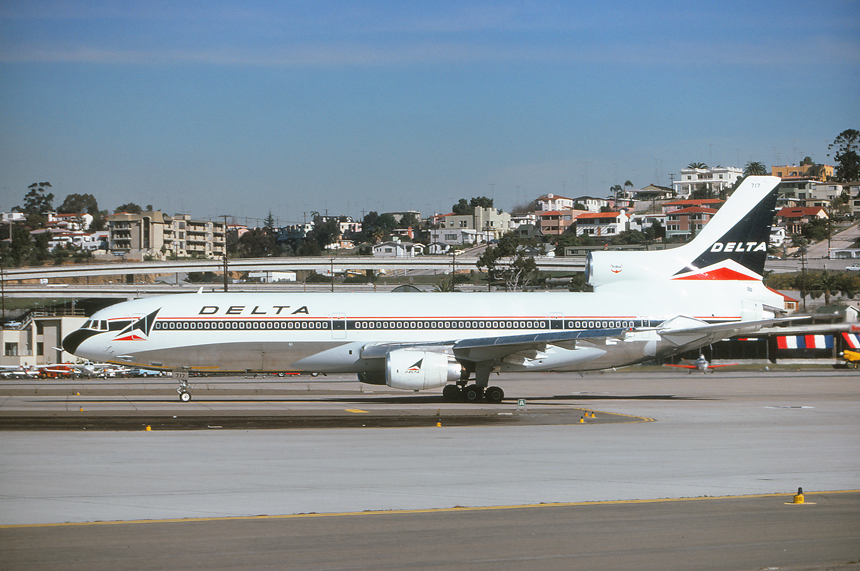
|
January 1975 Delta Airlines introduced their new Lockheed L-1011 "Tristar" to San Diego during the fall on 1974, as an extension of its Atlanta-Los Angeles-San Diego service. The new 250-passenger wide-body increased capacity in bringing "Snowbirds" from the frigid east into the balmy Southern California winters. Aligning up on Runway 27 for a quick 25-minute flight north to Los Angeles is N717DA, delivered just a few weeks earlier on December 13, 1974. |
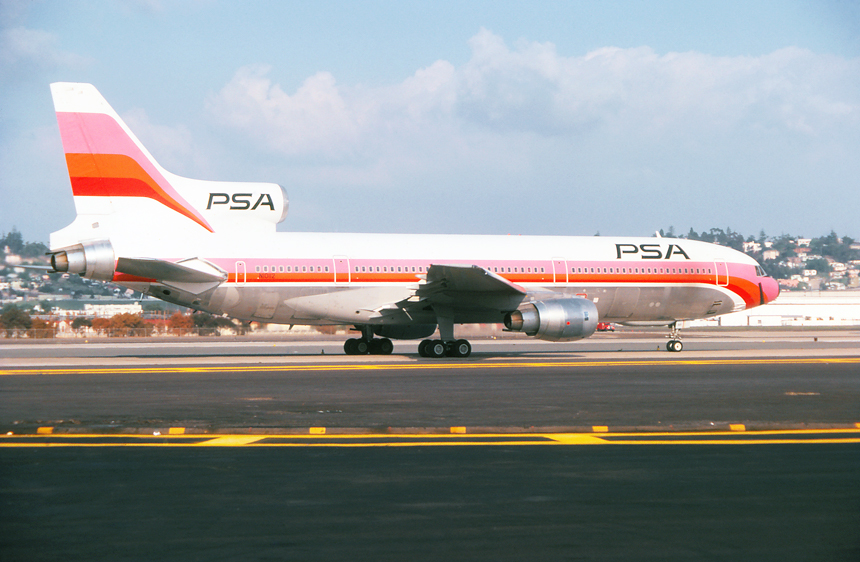
|
January 1975 Pacific Southwest Airlines (PSA), was struggling with the addition of gate space at both San Francisco and Los Angeles Airports. Both airports were the “Bread-and-Butter” of PSAs network, and the lack of additional gates was a direct impact to the airline’s capacity. As a unique solution, PSA President Andrews met with Lockheed, which was then developing the “space-age” L-1011 commercial airplane. The theory was one larger aircraft with a capacity of 300+ passengers could solve the problem of needing additional gates and require fewer flights. In August 1970, PSA signed a contract with Lockheed for two firm orders of the Lockheed L-1011, with an option for three additional airframes for an astonishing cost of $100 million. The first Lockheed L-1011 was delivered on July 2, 1974 and was immediately placed into service on the lucrative Los Angeles-San Francisco route. The second plane was delivered a month later and although affectionately known as "Mother Grinningbirds," the L-1011s were quickly realized to be inefficient with the rising fuel prices, lower demand in travel, and high operating costs. Both planes were subsequently removed from service no more than a year later and placed into storage. PSA could not accept delivery of the remaining three aircraft and eventually all five airframes found use with other carriers. Seen wearing the “hot pink” 1970s colors and taxiing out to Runway 27 for a mid-day departure is N10112, a Lockheed L-1011-1, delivered new to PSA on July 2, 1974. |
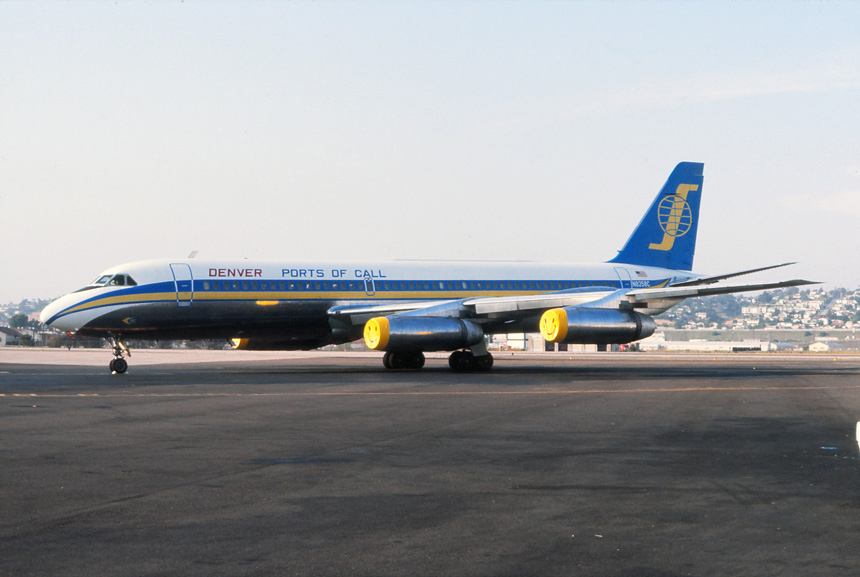
| August
1975 An occasional visitor into San Diego was the Denver based travel club airline, Ports-of-Call. The over 66,000 member strong travel club was established in 1966 to provide charter and tour-group based flights world-wide. San Diego was a popular destination for both charter and member based flights and the airline's Convair 990 and Boeing 707 aircraft were utilized for the occasional service. Parked at the overflow ramp just west of the cargo terminal is N8258C, a Convair 990A Coronado(30-A), originally built just across the airport at the Convair plant in 1962. |

|
September
1975 Pacific Southwest Airlines (PSA) sought a smaller aircraft to replace the aging Electra's and provide flights into the smaller secondary cities such as Fresno and Stockton. PSA eventually ordered twelve of the "Baby" Boeings with the first being delivered in September 1968. The 737 fleet only lasted a few years, as fleet standardization with the Boeing 727 drove PSA to dispose of the lower-capacity 737s by 1976. Parked on the ramp is N379PS, a Boeing 737-214, delivered new to PSA in October 1968. |
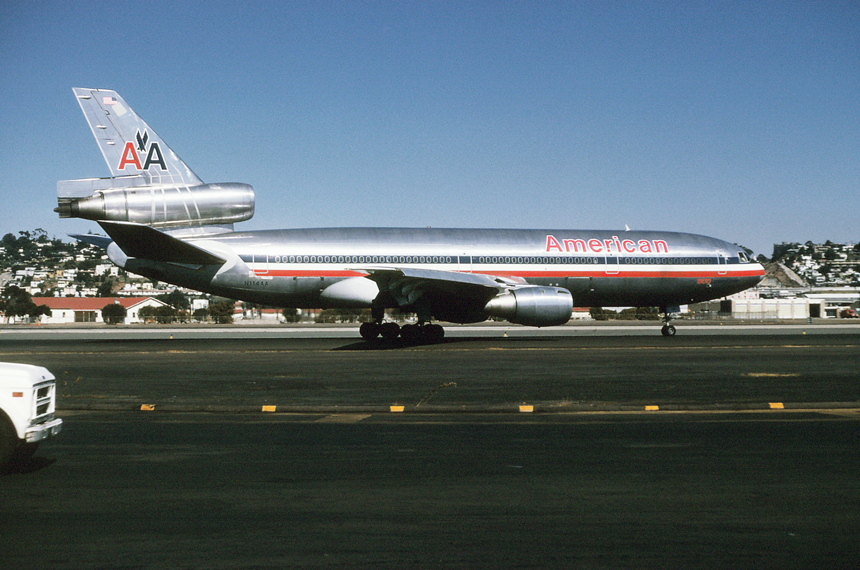
|
October 1975 American Airlines was one of the first airlines to introduce the new wide-body Douglas DC-10 in the spring of 1975. Early flights using the Tri-jet were to Los Angeles only a twenty minute flight north, where the plane continued on to Chicago or New York-JFK. American Airlines Flight 12 Heavy, N114AA, a Douglas DC-10-10 is caught taxiing outbound to Runway 27 for a 0910 departure to Los Angeles. |

|
October 1975 Following the lead of its airport neighbor American Airlines, United Airlines introduced Douglas DC-10 service into San Diego during 1975 with flights initially to Los Angeles followed by non-stop services to Chicago. Taxiing out to Runway 27 for a morning departure is N1819U, a Douglas DC-10-10, delivered new to the airline on April 12, 1973. This aircraft was subsequently destroyed on July 19, 1989, on a flight from Denver to Chicago when an catastrophic in-flight failure of the Number 2 engine resulted in a triple hydraulic failure and a crash landing at Sioux Gateway Airport in Iowa. |

|
October 1975 During the same month as the above picture, United Airlines showed off its new "Saul Bass" color scheme introduced in 1974 with patriotic red and blue cheat lines followed by and orange cheat ine and double "tulip" U design on the tail. Seen taxiing out to Runway 27 for a morning departure, N1837U, a Douglas DC-10-10, which had been delivered new to the airline just a few months earlier in May 1975. |
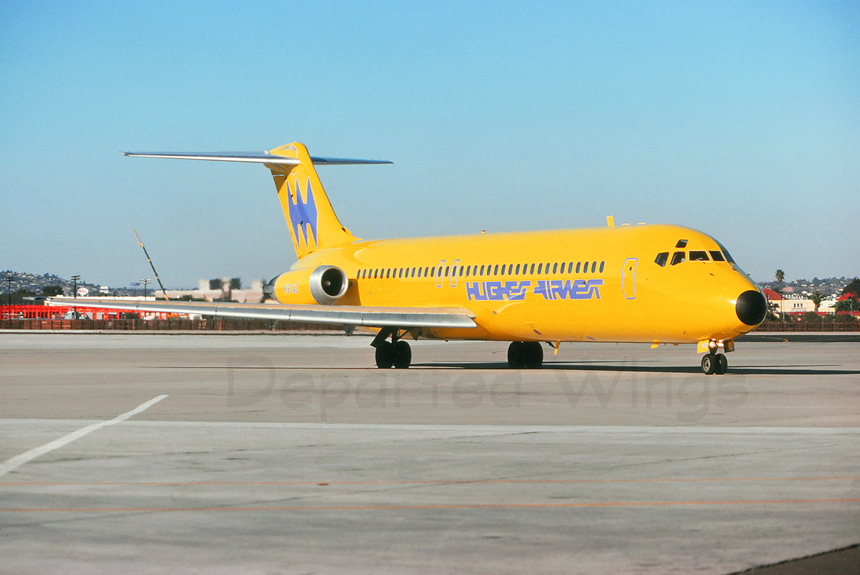
|
January 1976 Hughes Airwest was formed when eccentric billionaire Howard Hughes purchased Air West airlines in 1970, adding his last name to the carrier. Prior to the Hughes purchase, Air West had been formed by the 1968, merger of three "local service" airlines in the west, Bonanza Air Lines, Pacific Air Lines, and West Coast Airlines. After the Hughes purchase of Air West, the airline reduced flights and services into San Diego facing competition by home grown Pacific Southwest Airlines PSA. By 1976, Hughes Airwest was just serving two routes from San Diego; Las Vegas with one daily departure and Los Angeles with two departures. Seen taxiing outbound for a late afternoon departure to Los Angeles is N9342, a Douglas DC-9-31, originally delivered to Air West in May 1969. |
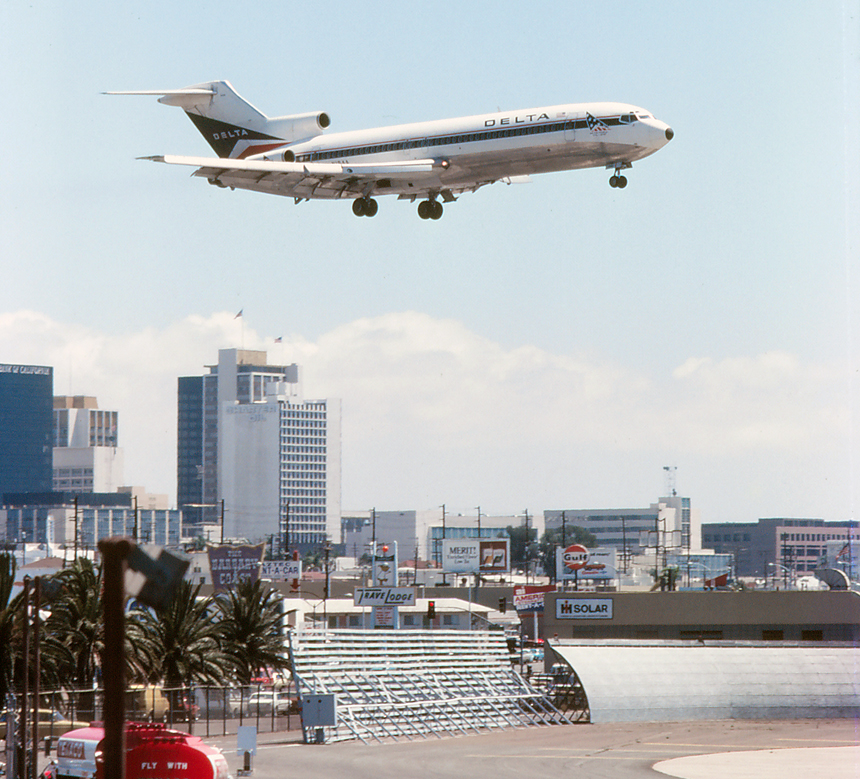
|
August 1976 In an effort to celebrate the bicentennial of the United States in 1976, Delta Airlines added the stars-and-stripes to its famous widget logo. The modification was started in October 1975 and promoted Delta's patriotic symbolism through their route network into 1977. Seen on short final to Runway 27 is N1644, a Boeing 727-295, delivered new To Northeast Airlines in January 1968, and taken by Delta during their purchase of the airline in August 1972 |
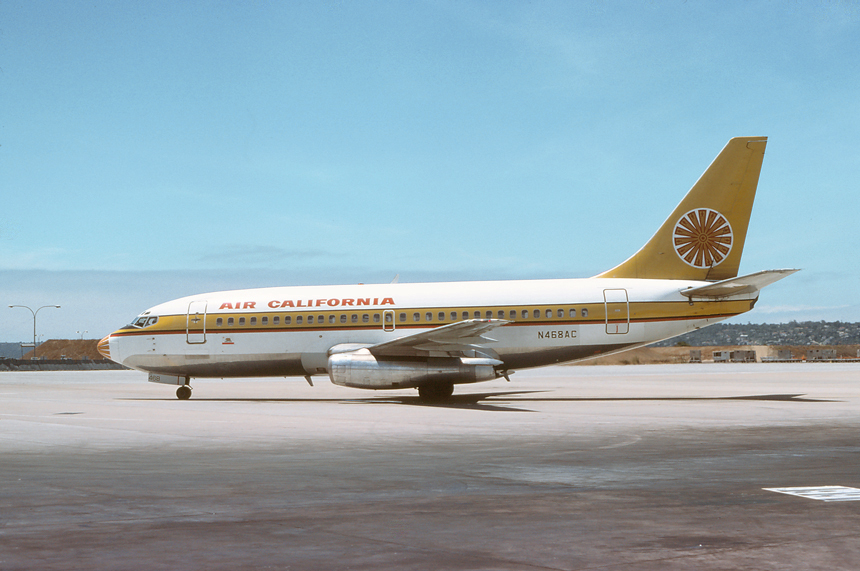
|
September 1976
Air California was able to prevail and maintain service to San Diego well into the 1980s, even with occasional competition on routes by its intra-state nemesis Pacific Southwest Airlines (PSA).Taxiing toward the gate is N468AC, a Boeing 737-293. This aircraft was subsequently lost in a landing accident at Santa Ana-Orange County Airport on February 17, 1981 after a missed approach go-around conducted too late resulted in a gear-up landing. |
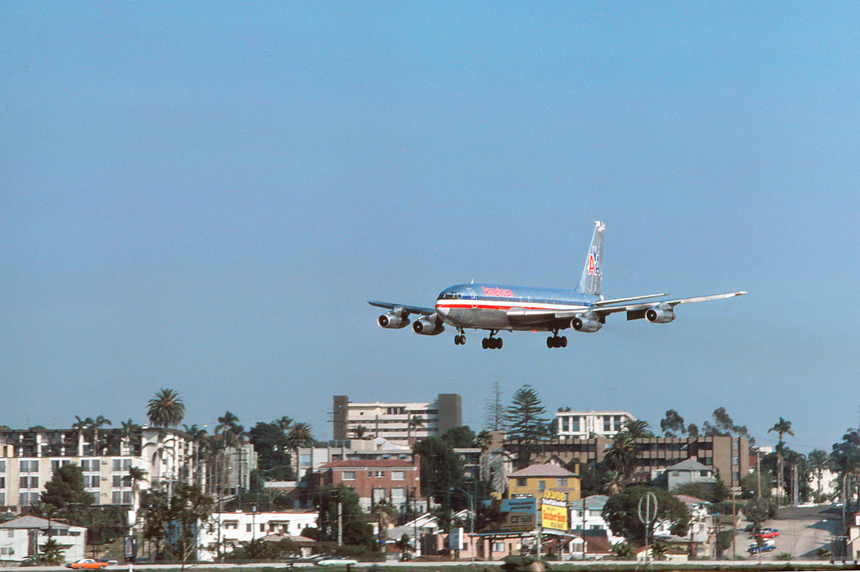
|
December 1976 San Diego was notorious for its rather steep, over-the-city approach into the most often used Runway 27. This example shows an arriving American Airlines Boeing 707 over Pacific Highway and Laurel Street and on short final to Runway 27 for landing. |

|
September
1977 A rather unique visitor to the San Diego airport was Texas International Airlines. Although Texas International did not have scheduled service in San Diego, the airline was a participant in the International Prisoner Transfer Program which was started in 1977, to transfer prisoners back to their home countries. The flights to San Diego were specific to the US-Mexico transfer agreement and usually quite full due to San Diego bordering Tijuana, Mexico. Preparing to depart on Runway 27 is N3504T, "City of Albuquerque," a Douglas DC-9-32. |
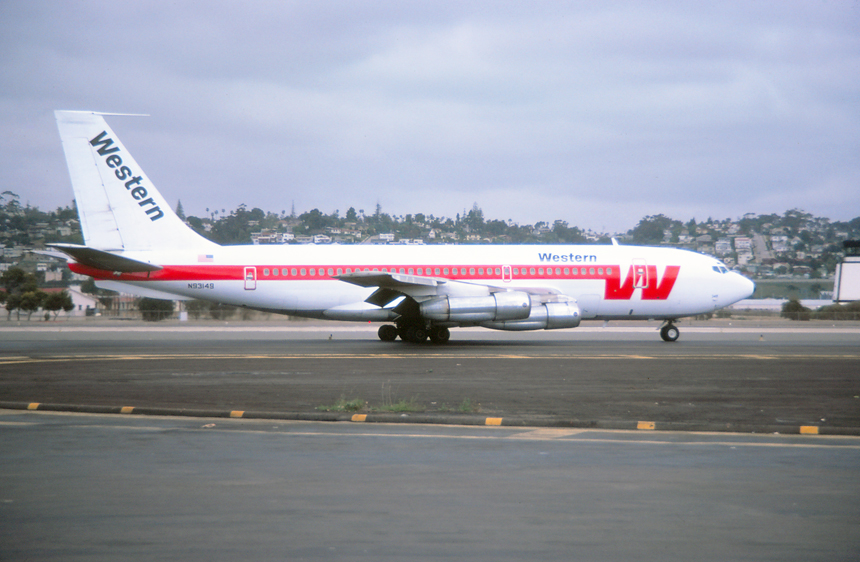
| April
1977 Western Airlines ordered the Boeing 720 jet airplane in early 1960 to better compete with the major carriers (such as United) along the popular Pacific Coastal routes. Due to delivery delays, Western purchased two Boeing 707-139s, originally destined for Cubana Airlines (but withdrawn due to the US-Cuba tensions). Western's first jet service started on June 1, 1960, from Los Angeles to Seattle via San Francisco and Portland. San Diego was introduced to Western's Boeing 707 service in 1963 when the plane was used on services to Phoenix, then continuing on to Denver and Minneapolis. Eventually the Boeing 707 was placed on services between San Diego and Honolulu in 1970. Seen taxiing out to Runway 27 on an overcast morning is N93149, a Boeing 720-047B, originally delivered to the airline in April 1963. |
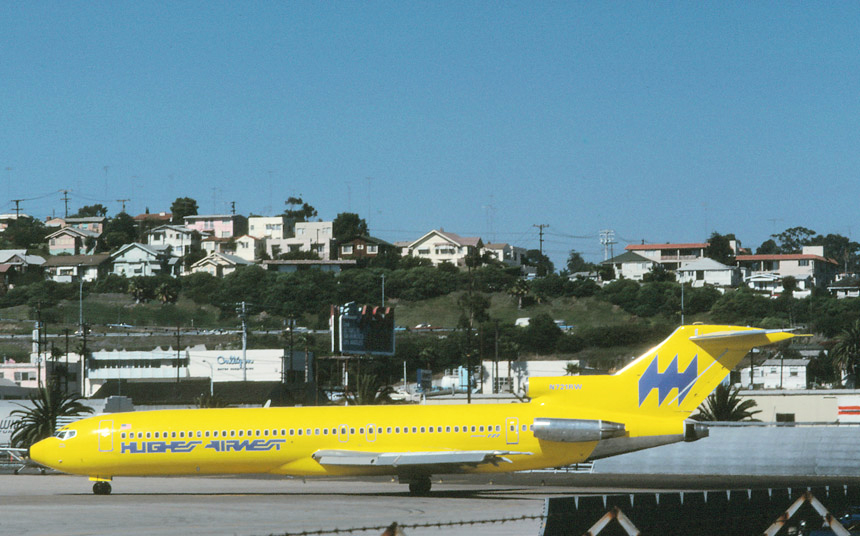
| August
1977 The first Boeing 727 received by Hughes Airwest in August 1977, was named "Spirit of Gamma," after Howard Hughes's Northrop Gamma aircraft he used to set three world speed records in 1936. This Boeing 727 was one of three, originally ordered, by Hughes Airwest for increased distance, performance and passenger capacity on new longer range routes. Although not a frequent visitor to San Diego, the Boeing 727 was occasionally used on routes between San Diego and Los Angeles and Salt Lake City, as well as being used for various sports charters. Seen turning onto the active Runway 27 for an afternoon departure is N721RW "Spirit of Gamma," a Boeing 727-2M7. |

|
September
1977 Hughes Airwest continued to maintain a small schedule from San Diego providing flights to Los Angeles, Las Vegas, and Tucson until its purchase by Republic Airlines in September 1980. Seen holding in position for takeoff on Runway 27 in the vibrant yellow "banana" color scheme is N920RW, a Douglas DC-9-31, originally delivered to Eastern Airlines in May 1968. |
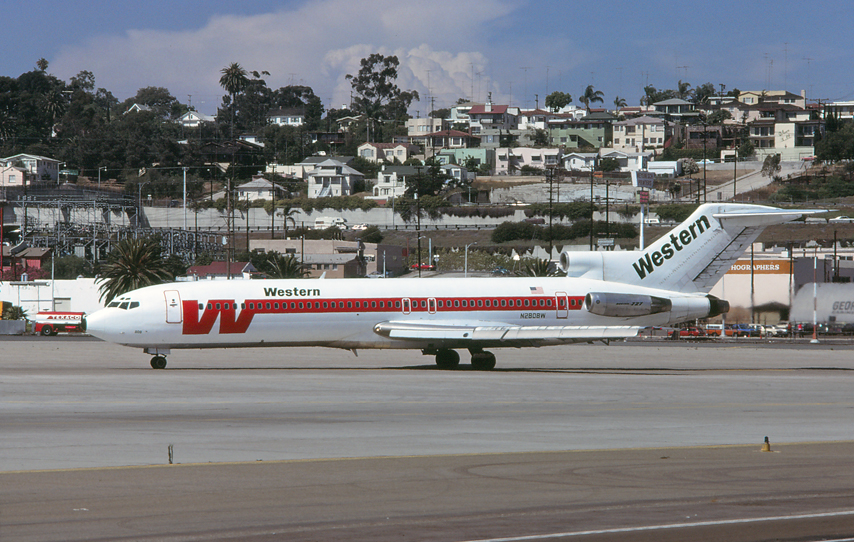
|
July 1978 Western Airlines introduced the Boeing 727 in October 1969, to supplement the existing Boeing 707 and 737 fleet. The airline specified the newer "stretch" series-200 version with a capacity of 135-passengers. The new 727s would be used on trunk services throughout the Western network and during the early 1970s saw service into San Diego from Denver, Los Angeles, and Phoenix. Rolling for takeoff on Runway 27 for a flight to Salt Lake City is N2808W, a Boeing 727-247 Advanced, originally delivered to Western Airlines on June 13, 1972. |

| August
1978 Continental Airlines started service into San Diego in September 1976, using Boeing 727s on flights to both Denver and Houston. This new destination for Continental was in direct competition with United's flights to Denver and National's flights to Houston, however, Continental's signature service made it a viable choice for both business and pleasure travelers. Seen taxiing out to Runway 27 for a mid-day departure to Denver is N69740, a Boeing 727-224. |
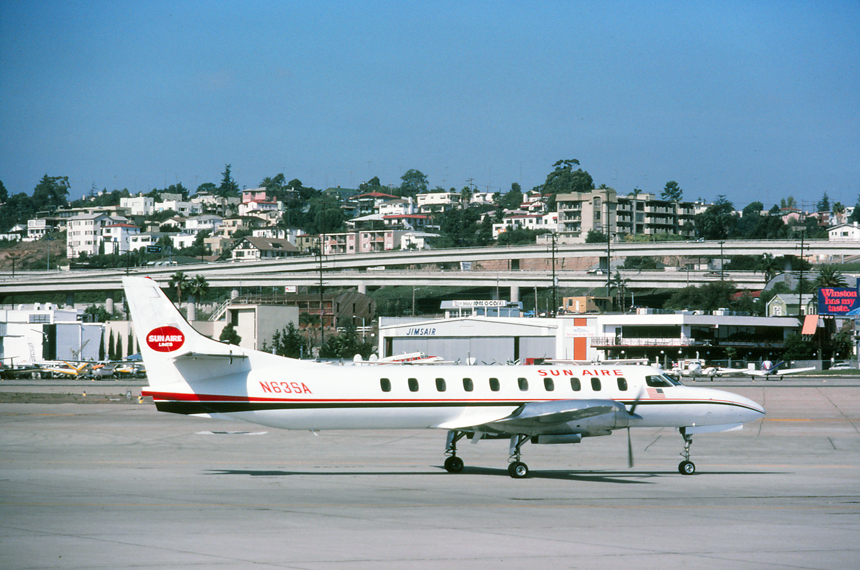
|
December 1978 Local commuter airline Sun Aire received its commuter certificate in 1968, to provide service to the desert resort town of Borrego Springs, located in the Anza-Borrego desert. The airline received its first Swearingen Metroliner in 1975, and started turboprop service between Borrego Springs, Palm Springs and San Diego. By 1978, Sun Aire had added Los Angeles and Burbank to it's route map and established itself as a reliable alternative to the "jet" carriers on the popular Los Angeles-Palm Springs route. The airline provided and maintained an important link between San Diego and Borrego Springs, a route overland taking about two hours over mountainous terrain versus a 20 minute "hop" by turboprop. Seen approaching Runway 27 for a mid-day departure is N63SA, a Swearingen SA226TC Metroliner. |
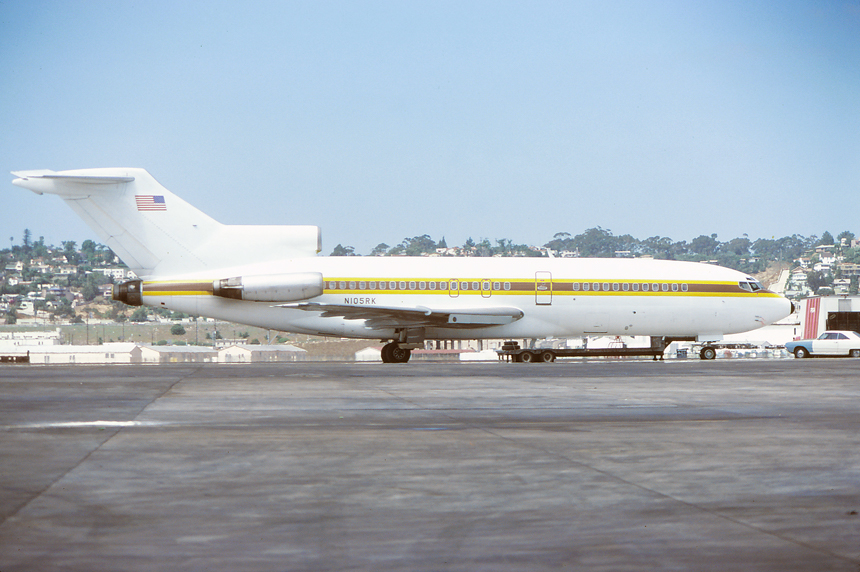
|
June 1979 Ray Kroc of McDonalds hamburger fame, was an avid baseball fan and purchased the ailing San Diego Padres baseball franchise in January 1974. As part of his ownership of the team, he purchased a converted Boeing 727 to serve as the team plane for games away from home. The plane was purchased in 1978 and based at San Diego-Lindbergh Field. It was used for three seasons when it was eventually sold off. Parked on the cargo ramp and wearing the Padres team colors, both yellow and brown is N105RK, a Boeing 727-51, originally delivered to Northwest Airlines September 1966, and purchased by the San Diego Padres Baseball Club in February 1978. |

|
March 1980 By 1980, United Airlines was operating one-hundred eighty (180) Boeing 727 airplanes and using the versatile jet on a majority of its short and medium range services. From the eleven cities United was flying to from San Diego in early 1980, nine of the city pairs were being flown by the Boeing 727. From the short-hop north to Los Angeles to the non-stop flights to Cleveland, Ohio, the Boeing 727 was a perfect fit for San Diego service. Lining up on Runway 27 for a mid-morning departure is N7060U, a Boeing 727-22, delivered new to United Airlines on March 30, 1966. |

|
September 1980 During summer of 1979 (after the return of the grounding of the DC-10s), American replaced its non-stop Boeing 707 service between San Diego and New York-JFK with the Douglas DC-10. With a capacity of about 270-passengers, the DC-10 proved popular on the daily, transcontinental service to the Big Apple. Having just been pushed back from the West Terminal and awaiting taxi clearance is N107AA, a Douglas DC-10-10, delivered new to American Airlines on December 15, 1971. |
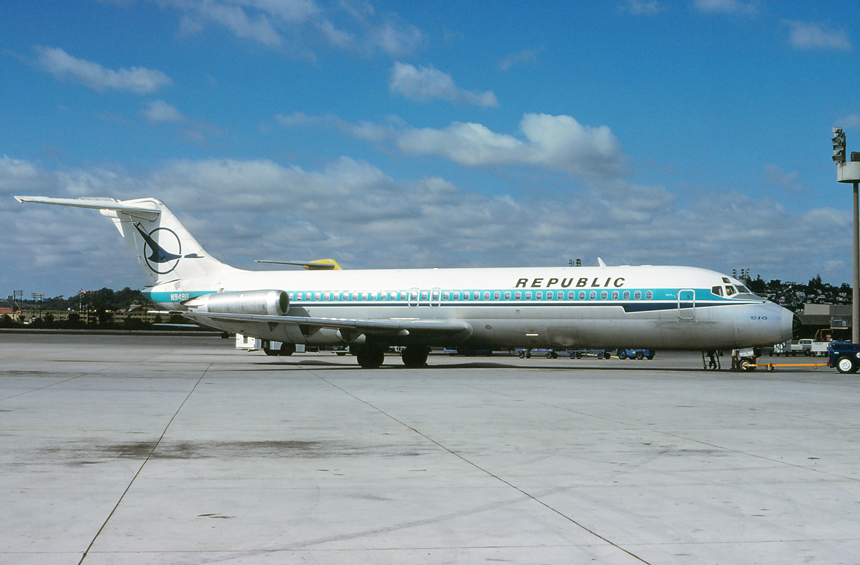
|
September 1980 Republic Airlines was formed by the merger of both North Central Airlines and Southern Airways in July 1979. Republic became the first "airline" to form after the Deregulation Legislation passed a year before in 1978. The new airline had an extensive route structure east of the Rockies providing service to over one hundred cities and communities. Seeking to extend it reach west, Republic introduced service to San Diego from Minneapolis-St. Paul via Las Vegas, Nevada in April 1980. The new service used the Douglas DC-9 and completed a transcontinental route map for Republic, whereby service was now truly coast-to-coast. Only a few months later would Republic Airlines presence on the Pacific Coast be strengthened with the purchase of Hughes Airwest in September 1980. Parked at the gate at the East Terminal and still wearing the color scheme of previous operator North Central Airlines is N949N, a Douglas DC-9-31, originally delivered new to North Central Airlines on April 10, 1973. |
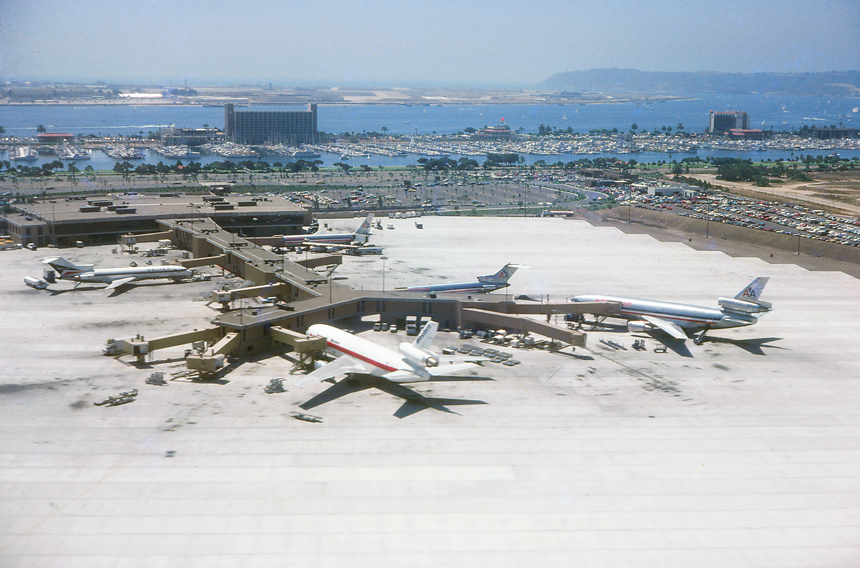
|
September 1980 In an effort to keep pace with the growing passenger demand of the San Diego region, the Port of San Diego (operators of the airport), constructed Terminal 2 just west of the existing Terminal 1. The new terminal was completed in July 1979 and had gate space for eleven aircraft including five for wide-bodies. Seen from a departing flight is Terminal 2 with a Delta Airlines Boeing 727, Western Airlines Douglas DC-10, and a trio of American Airlines aircraft including a Douglas DC-10, Boeing 727 and Boeing 707. Behind the airport is Harbor Island complete with its hotels and various boat marinas. |
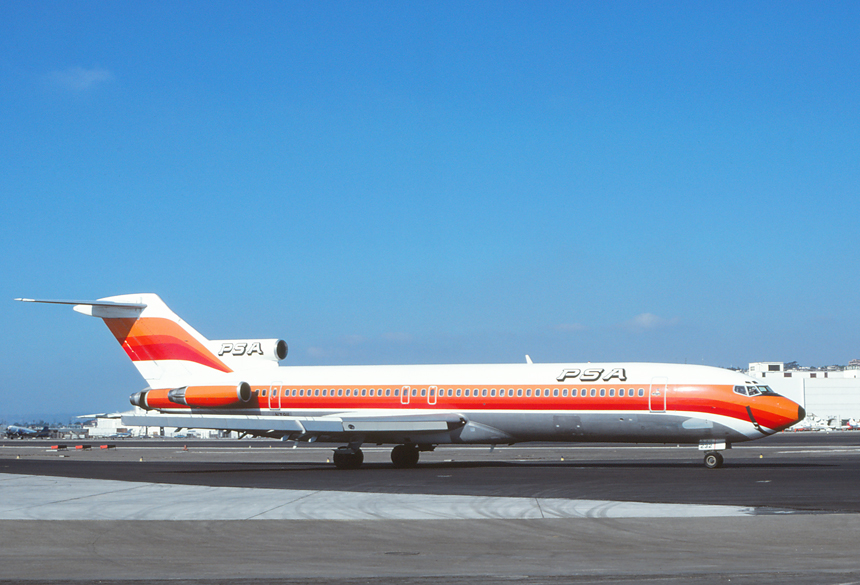
|
November 1980 San Diego's hometown airline, Pacific Southwest Airlines (PSA) had placed the Boeing 727 as the basis for its intra-state operations and the foundation of it's fleet. The trusty Boeing trijet, had the reliability, passenger capacity and range to easily provide frequent flights throughout its multi-city schedule. Entering the 1980s, PSA had a fleet of thirty-one 727s and each was now wearing the updated colors of the more traditional red, red-orange and orange stripes versus the "hot pink" version of the early 1970s. Taxiing outbound toward Runway 27 is N791L, a Boeing 727-2Q8 on lease from ILFC (International Lease and Finance Corporation) and delivered to PSA on January 9, 1979. |

|
November 1980 By the late 1970s, Delta Airlines had seven daily flights into the airport and had added non-stop service to it's home base of Atlanta to the schedule. In 1980, Delta placed the Boeing 727 on the non-stop flight to Atlanta as well as on new services to Phoenix, Arizona. Taxiing out to Runway 27 is Delta Airlines Flight 442 with non-stop service to Atlanta continuing on to Charlotte, South Carolina, using N507DA, a Boeing 727-232, delivered new to Delta Airlines on September 15, 1977. |
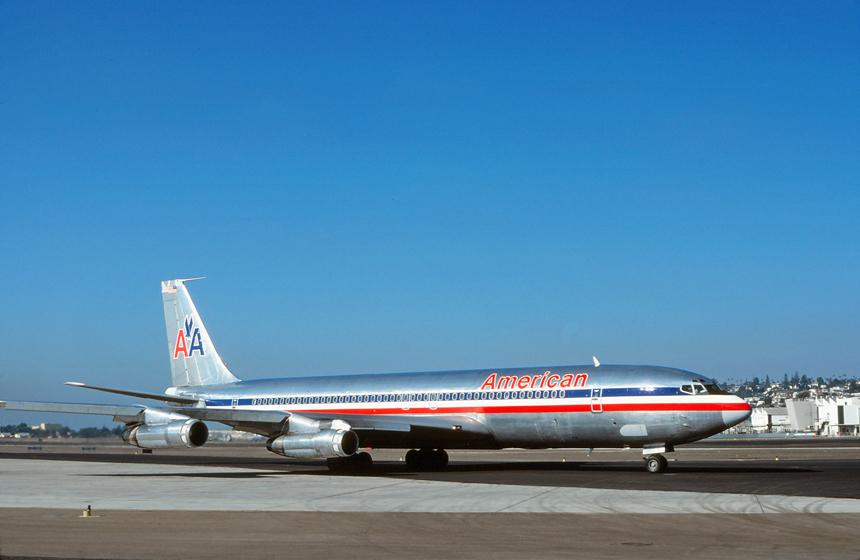
|
November 1980 American Airlines had placed its first Boeing 707 in service in 1959, and the venerable plane was still flying routes in 1980, over twenty years later. Although the 707, was becoming more costly to maintain, it was still be used on city pairs where the larger Douglas DC-10 was uneconomical, especially on transcontinental routes to secondary cities. In 1980, American's Boeing 707s were flying routes from San Diego to Chicago, Dallas-Ft. Worth, St. Louis, and Washington-Dulles. Within a few years, American finally decided to retire the 707 from service replacing them with the Boeing 727 and new Boeing 767s. Taxiing toward Runway 27 for a morning departure is N8436, a Boeing 707-323B, delivered new to American in June 1969. |

|
December 1980 Orange County based regional commuter Golden West purchased de Havilland Canada's newest turboprop, the Dash 7 in March 1980 to increase capacity on trunk routes. The Dash 7 was specifically used to fly the important San Diego-Los Angeles route and no less then four flights were flown daily using the fifty-passenger airplane. Holding short of Runway 27 and awaiting a departing Pan Am Boeing 727 is N701GW, a de Havilland DHC-7-102 "Dash 7," delivered new to Golden West in March 1980. |
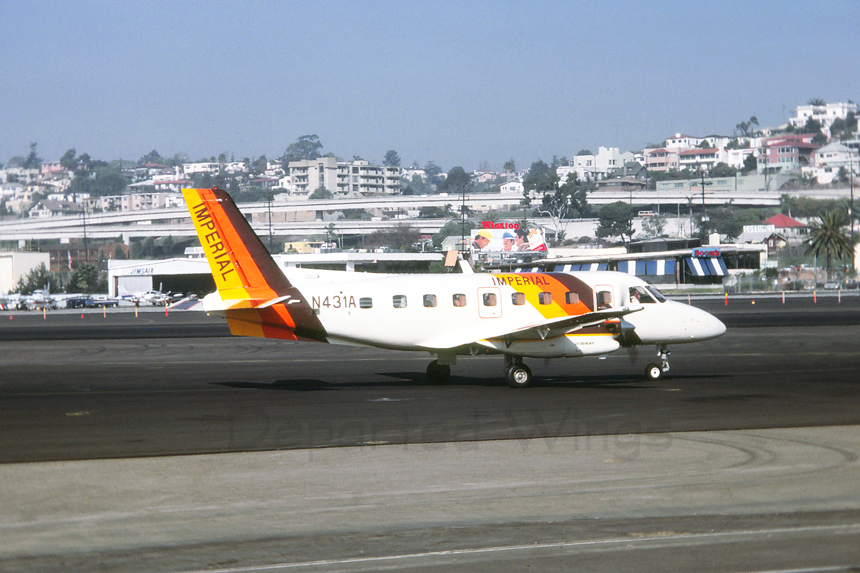
|
December 1980 Starting operations in 1964, at Imperial County Airport near El Centro, Imperial Airlines initially provided commuter flights between San Diego and Imperial County Airport. In 1980, the airline moved its headquarters to Carlsbad, and expanded flights across the Southern California region using the Embraer EMB-110 Bandeirante, By December 1980, Imperial was providing flights from San Diego to El Centro-Imperial, Carlsbad, and Los Angeles. Los Angeles was served specifically with departures every 30-minutes during the weekdays. Seen holding for takeoff during a mid-morning departure is N431A, an Embraer EMB-110P1. |
Back to: The Airports